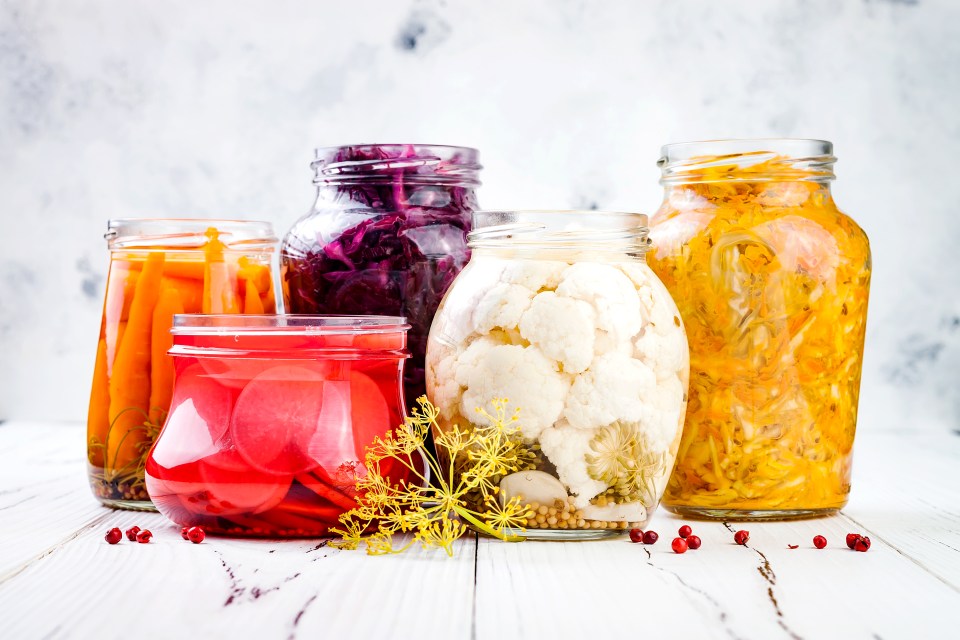The 6 cheap ‘superfoods’ that are key to flawless skin, weight loss and help prevent balding
If you want to improve your digestion and gut health, fermented foods are the best.
However, these meals may also help you lose weight and have other health benefits.
According to a recent South Korean study, kimchi, which costs less than $5 per tub in stores and pennies to eat daily, has anti-obesity properties.
The study examined anthropometric changes in 55 overweight adults, including both males and females, in terms of blood biomarkers, gut microbiomes, and BMI.
For two weeks, participants took three kimchi capsules that contained kimchi powder.
After analyzing the changes in their body fat composition, the researchers discovered that the group that ate kimchi had a 2.6% reduction in body fat.
Read more on gut health
A statistically significant difference between the two groups was demonstrated by the 4.7% increase in body fat in the control group, which did not consume the kimchi capsules.
According to an investigation of the participants’ microbiomes, eating kimchi increased the amount of the gut bacterial Akkermansia muciniphila, which has been shown to reduce inflammation, and decreased the number of Proteobacteria, which are linked to obesity.
The results of this clinical study demonstrated that consistent kimchi consumption can reduce the symptoms of obesity by altering gut flora.
“The results of a preclinical study and a clinical trial have systematically verified the anti-obesity effects of kimchi, and present scientific evidence that would help to make the excellent properties of kimchi widely known, laying the foundation for the growth of kimchi as a health food well recognized around the world,” stated Dr. Hae-Choon Chang, Director of the World Institute of Kimchi, which conducted the study.
We will keep investing time, energy, and resources in scientific research to support the health-functional qualities of kimchi, including its ability to improve gastrointestinal health in addition to its immune-boosting and anti-cancer effects, solidifying its position as a global health food, she continued.
Here are 5 tips to keep your gut microbiome healthy
Fermented foods and gut health
The advantages of fermented foods like yoghurt, kefir, sauerkraut, and kimchi are being more and more supported by research.
These foods have been fermented, which encourages the development of probiotics that can benefit your health.
Your gut is home to thousands of different kinds of microorganisms, such as bacteria, viruses, yeasts, and fungi, according to Catherine Nash, a gastroenterology dietitian at Oxford Gastro Dietitians.
Currently, there is a lot of emphasis on gut health, and one strategy to take care of the stomach is to promote the diversity of the gut ecology, or biome.
Consuming fermented foods can assist your gut’s bacteria become more diverse, and if we take care of our gut, it may have further beneficial impacts on our bodies.
Here, we examine the health advantages of consuming kimchi and other gut-friendly foods, ranging from healthier skin to better mental health.
1. Kimchi – best for weight loss and preventing hair loss
According to Liv Morrison, clinical dietitian and nutritionist for the health and wellness app Kic, “Kimchi is a traditional Korean fermented snack that is typically eaten as an accompaniment to meals. It has a sour and spicy flavor.
Although the ingredients might change, kimchi is often created by fermenting and salting cucumber, radish, or cabbage along with additional ingredients like onion and garlic.
As a fermented food, it enriches your gut with beneficial bacteria. According to Catherine, it has fiber, which helps to grow good bacteria, as well as essential vitamins like A and C.
In addition to its weight-loss and digestive benefits, kimchi has been shown to thicken hair and even stop balding.
In 2019, a small study examined guys who ate kimchi twice a day and were in the early phases of hair loss. The average number of hairs per square centimeter rose from 85 to 90 after one month, and then to 92 after four months.
The majority of supermarkets in the Asian sector, such as Aldi, Sainsbury’s, and Tesco, carry kimchi.
2. Sauerkraut – best for digestion
Fermented cabbage is called sauerkraut. Although the German word for sauerkraut means “sour cabbage,” the meal originated in China more than 2,000 years ago.
Similar to kimchi, bacteria found in sauerkraut help maintain gut health and include vitamins A and C.
Sauerkraut has been shown in clinical trials to help reduce the symptoms of irritable bowel syndrome (IBS).
According to findings from other research, probiotics, which are present in fermented foods like sauerkraut, may help prevent and treat breast cancer.
Liv states: Human studies have demonstrated the multiple health advantages of frequent eating of both kimchi and sauerkraut, which are potent anti-inflammatory foods.
These include decreasing blood sugar, body fat, and cholesterol; avoiding the development of many types of cancer, especially breast and colon cancer; preventing heart disease and artery narrowing; and enhancing metabolic and immune health.
Making sauerkraut at home is really simple and only requires three ingredients: cabbage, water, and salt, as well as a jar.
The fermented cabbage can then be added to a ham sandwich, mixed into a salad, or made into a dip.
You can also find it in a health food store or at the supermarket, where it’s frequently labeled as Polish or Bavarian.
3. Kefir – best for skin
Made from milk and kefir grains, which are colonies of yeast, kefir is a fermented beverage that has a tangier taste and appearance than thin yogurt.
It’s now a common sight in most supermarket milk refrigerators, but it’s also used to make yoghurt. These typically contain flavorings, but with the correct equipment, you can also produce them at home.
One of the most studied kinds of fermented foods, kefir has been strongly associated with better digestion and gut health.
Drinking kefir has been shown to strengthen the skin barrier and enhance skin health; one study revealed that the homemade product helped people with atopic dermatitis (eczema).
Because a weakened skin barrier can exacerbate allergies and skin disorders, it might be a useful option for people with chronic skin conditions.
In the meanwhile, milk-based kefirs’ high calcium content can help maintain strong bones and lower the risk of osteoporosis.
4. Natto and tempeh – best for bones
According to Liv, natto is a classic Japanese food prepared from fermented whole soybeans that is frequently consumed for breakfast or as a snack.
Since soybeans have a fairly neutral flavor, the spice you choose will affect how natto tastes.
Natto is sticky and smells strongly when it is served.
Among other vitamins and minerals, natto has a high dietary fiber content, which helps with digestion and eases constipation.
According to Liv, natto has a lot of nutrients, namely calcium, vitamin K, iron, and potassium. These are excellent for lowering blood pressure, enhancing immunity, bone density, and kidney and heart health.
In addition to managing weight, fiber helps prevent heart disease and colon cancer.
Because natto was most closely linked to less bone loss in middle-aged women, Japanese researchers advised menopausal women to consume it.
Fermented soybeans are also used to make tempeh. It is native to Indonesia, resembles tofu, and is frequently used as a high-protein substitute for meat.
Similar to natto, tempeh has a high fiber content and can lower cholesterol and promote intestinal health.
5. Yoghurt – best for mental health
As part of a nutritious diet, yoghurts—made from fermented milk—are popular, but they can also have positive effects on mental health.
Certain bacteria present in yoghurt have been shown in studies to have the ability to elevate mood and alleviate the symptoms of anxiety and sadness.
According to Liv, psychobiotics are probiotic meals that have been demonstrated to have positive effects on mental health.
Natural, well-studied sources of psychobiotics include tempeh, kimchi, kefir, and Greek yoghurt.
Numerous beneficial bacterial strains have been demonstrated to affect mood through pathways in our immune system.
The process by which our gut bacteria interact with our brain to produce physical changes is known as microbiota-gut-brain signaling.
Since this field of study is still in its infancy, it will be some time before we can recommend particular bacterial strains to treat mental health issues.
Read More on The US Sun
In any case, the evidence is encouraging, and adding naturally fermented foods at this time is safe.
Choose the natural kind of yoghurt rather than the sugary, sweetened ones if you want the best.
Make your own fermented foods
Sauerkraut
Recipe creator and @Leelalicious demonstrates how to make sauerkraut at home in her TikTok.
Shred about one kilogram of cabbage first. Add one tablespoon of salt, optionally shredded carrot, and caraway seeds, and stir.
Combine the ingredients and massage until the cabbage produces liquid.
Place everything in a mason jar and keep the cabbage buried in the liquid by using a weight of some sort. You can buy fermentation crocks, jars and kits online, too.
Leave to ferment for one to four weeks at room temperature. In the first week, check if the cabbage is submerged in the liquid and push down if not.
Taste the sauerkraut and when it is to your desired taste, refrigerate and eat when desired.
Kimchi
Kimchi takes a little more time and ingredients, which you may be best sourcing at an Asian market.
Intheir video, @two.plaid.apronsstart by salting 3kg of napa cabbage, covering it in a bowl and weighing it down for at least two hours. You ll need about two cups of Kosher salt. The cabbage is rotated every 30 minutes or so.
To make the marinade, make rice flour paste (30g rice flour and 355ml of water) and leave to cool.
Blend a large apple, onion, 20 garlic cloves, two-inch knob of ginger, and a 118ml of fish sauce. Then, add 220g of gochugaru.
Mix together the marinade and rice flour paste, then add in 500g Korean radish, 170g carrot, and 113g Asian chives (all optional).
Once the cabbage is done salting, rinse with water and squeeze out excess water. Carefully mix into the marinade.
Tightly pack the mixture into a glass container, leaving room between the top of the mixture and the lid. It will be ready to eat once chilled, but you can let it ferment.
Find the full recipehere.
Note: Thank you for visiting our website! We strive to keep you informed with the latest updates based on expected timelines, although please note that we are not affiliated with any official bodies. Our team is committed to ensuring accuracy and transparency in our reporting, verifying all information before publication. We aim to bring you reliable news, and if you have any questions or concerns about our content, feel free to reach out to us via email. We appreciate your trust and support!















